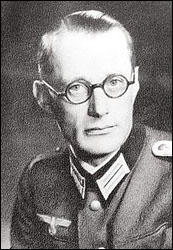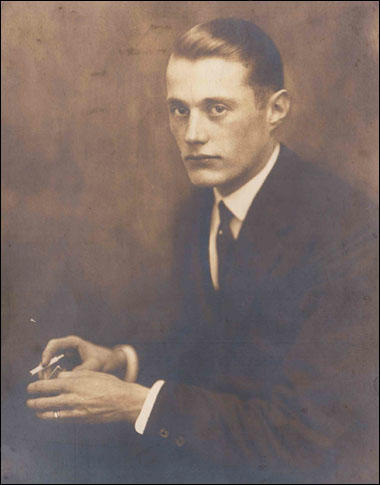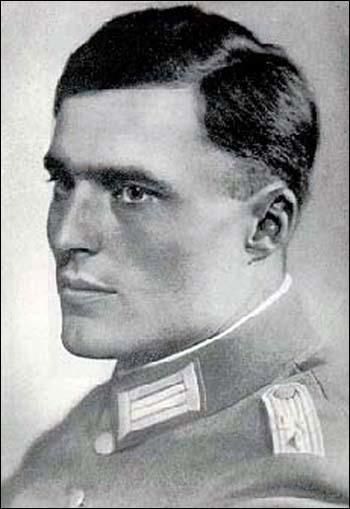Ulrich-Wilhelm Graf von Schwerin

Ulrich-Wilhelm Graf von Schwerin von Schwanenfeld was born on 21st December 1902. He spent his early years at Rossleben School, completing his schooling in 1921. He studied agriculture in Munich, Berlin, and Breslau. A few months after completing his studies in 1926, he inherited the agricultural estates of Göhren in Mecklenburg-Strelitz and Sartowitz in then Polish West Prussia. In 1928 he married Marianne Sahm and over the next years the couple had five sons. (1)
A devout Christian, Schwerin was an early opponent of the Nazi Party and in 1935 he advocated the overthrow of Adolf Hitler by force to bring about a Christian renewal in Germany. (2)
He became an important link between the civilian and military opposition during the 1938 Sudetenland Crisis due to his contacts to the Foreign Office and the Office for Foreign Affairs/Counterintelligence in the Armed Forces High Command. During this period he was in regular contact with other anti-Nazis including Fritz-Dietlof von der Schulenburg, Peter Graf Yorck von Wartenburg, Caesar von Hofacker and Hans Oster. (3)

On the outbreak of the Second World War Schwerin was appointed to the staff of Field Marshal Erwin von Witzleben, who also had doubts about Hitler's foreign policy. (4) In 1939 Schwerin became aware of atrocities being carried out by the German Army in Poland. (5) Schwerin passed on this information to other members of the resistance including Ulrich Hassell and Carl Goerdeler. In January 1941 Hassell visited General Carl-Heinrich von Stülpnagel and talked about the possible assassination of Hitler when he visited Paris in May. Schwerin pledged himself to throw a bomb at Hitler if opportunity offered, perhaps from a hotel balcony. However, Hitler cancelled his trip at the last moment. (6)
On 17th January 1942, as agreed by leading members of the German Resistance, including Hans Oster, Hans Dohnanyi. Carl Goerdeler, Johannes Popitz and Ludwig Beck, the diplomat, Ulrich Hassell, visited Graf von Schweri and Field Marshal Erwin von Witzleben to discuss Goerdeler's proposal that the coup should initiated by a putsch under Witzleben. Although he agreed with the idea of a coup, Witzleben complained that he did not have enough fighting troops for this to be successful. "The result would be a struggle for power approximating to civil war which the Nazis might easily win through use of their auxiliary forces, their hold on the actual reins of government with its consequent prestige, their popularity and their methods of mass indoctrination. Unless simultaneous action was taken against Hitler himself and his immediate entourage, no putsch had a hope of success." (7)
Claus von Stauffenberg eventually agreed to assassinate Hitler. But before he took action he wanted to make sure he agreed with the type of government that would come into being. Conservatives such as Carl Goerdeler and Johannes Popitz wanted Field Marshal Erwin von Witzleben to become the new Chancellor. However, socialists in the group, such as Julius Leber and Wilhelm Leuschner, argued this would therefore become a military dictatorship. At a meeting on 15th May 1944, they had a strong disagreement over the future of a post-Hitler Germany. (8)
Stauffenberg was highly critical of the conservatives led by Carl Goerdeler and was much closer to the socialist wing of the conspiracy around Julius Leber. Goerdeler later recalled: "Stauffenberg revealed himself as a cranky, obstinate fellow who wanted to play politics. I had many a row with him, but greatly esteemed him. He wanted to steer a dubious political course with the left-wing Socialists and the Communists, and gave me a bad time with his overwhelming egotism." (9)
The conspirators eventually agreed who would be members of the government. Schwerin was going to be a Secretary of State. Other appointments included: Head of State: Colonel-General Ludwig Beck, Chancellor: Carl Goerdeler; Vice Chancellor: Wilhelm Leuschner; State Secretary: Peter Graf Yorck von Wartenburg; Foreign Minister: Ulrich Hassell; Minister of the Interior: Julius Leber; State Secretary: Lieutenant Fritz-Dietlof von der Schulenburg; Chief of Police: General-Major Henning von Tresckow; Minister of Finance: Johannes Popitz; President of Reich Court: General-Major Hans Oster; Minister of War: Erich Hoepner; State Secretary of War: General Friedrich Olbricht; Minister of Propaganda: Carlo Mierendorff; Commander in Chief of Wehrmacht: Field Marshal Erwin von Witzleben; Minister of Justice: Josef Wirmer. (10)

On 16th July, 1944, Ulrich-Wilhelm Graf von Schwerin had a meeting with Claus von Stauffenberg, and his closest friends, Peter Graf Yorck von Wartenburg, Fritz-Dietlof von der Schulenburg, Adam von Trott, Caesar von Hofacker and Albrecht Metz von Quirnheim. According to Joachim Fest: "There is some indication that Stauffenberg was eager to hold this lengthy discussion, which stretched well into the night, in order to allay once and for all both his own qualms about doing 'the dirty deed' and those of so many others." (11)
On 20th July, 1944, Stauffenberg entered the wooden briefing hut, twenty-four senior officers were in assembled around a huge map table on two heavy oak supports. Stauffenberg had to elbow his way forward a little in order to get near enough to the table and he had to place the briefcase so that it was in no one's way. Despite all his efforts, however, he could only get to the right-hand corner of the table. After a few minutes, Stauffenberg excused himself, saying that he had to take a telephone call from Berlin. There was continual coming and going during the briefing conferences and this did not raise any suspicions. (12)
Stauffenberg went straight to a building about 200 hundred yards away consisting of bunkers and reinforced huts. Shortly afterwards, according to eyewitnesses: "A deafening crack shattered the midday quiet, and a bluish-yellow flame rocketed skyward... and a dark plume of smoke rose and hung in the air over the wreckage of the briefing barracks. Shards of glass, wood, and fiberboard swirled about, and scorched pieces of paper and insulation rained down." (13)
Stauffenberg observed a body covered with Hitler's cloak being carried out of the briefing hut on a stretcher and assumed he had been killed. He got into a car but luckily the alarm had not yet been given when they reached Guard Post 1. The Lieutenant in charge, who had heard the blast, stopped the car and asked to see their papers. Stauffenberg who was given immediate respect with his mutilations suffered on the front-line and his aristocratic commanding exterior; said he must go to the airfield at once. After a short pause the Lieutenant let the car go. (14)
According to eyewitness testimony and a subsequent investigation by the Gestapo, Stauffenberg's briefcase containing the bomb had been moved farther under the conference table in the last seconds before the explosion in order to provide additional room for the participants around the table. Consequently, the table acted as a partial shield, protecting Hitler from the full force of the blast, sparing him from serious injury of death. The stenographer Heinz Berger, died that afternoon, and three others, General Rudolf Schmundt, General Günther Korten, and Colonel Heinz Brandt did not recover from their wounds. Hitler's right arm was badly injured but he survived. (15)
However, General Erich Fellgiebel, Chief of Army Communications, sent a message to General Friedrich Olbricht to say that Hitler had survived the blast. The most calamitous flaw in Operation Valkyrie was the failure to consider the possibility that Hitler might survive the bomb attack. Olbricht told Hans Gisevius, they decided it was best to wait and to do nothing, to behave "routinely" and to follow their everyday habits. (16) Major Albrecht Metz von Quirnheim long closely involved in the plot, had already begun the action with a cabled message to regional military commanders, beginning with the words: "The Führer, Adolf Hitler, is dead." (17) As a result, Schwerin, Peter Graf Yorck von Wartenburg, Ludwig Beck, Eugen Gerstenmaier, and Fritz-Dietlof von der Schulenburg arrived at army headquarters in order to become members of the new government. (18)
Stauffenberg arrived back in Berlin and went straight to see General Friedrich Fromm. Stauffenberg insisted that Hitler was dead. Fromm replied that he had just learnt from Field Marshal Wilhelm Keitel that Hitler had survived the bomb attack. Stauffenberg replied, "Field Marshal Keitel is lying as usual. I myself saw Hitler being carried out dead." He then admitted that he had planted the bomb himself. Fromm became very angry and declared that all the conspirators were under arrest, whereupon Stauffenberg retorted that, on the contrary, they were in control and he was under arrest. (19)
Shortly after the assassination attempt, Joseph Goebbels broadcast a communiqué over German radio, assuring the public that Hitler was alive and well and that he would speak to the nation later that evening. Goebbels began the broadcast with the following words: Today an attempt was made on the Führer's life with explosives... The Führer himself suffered no injuries beyond light burns and bruises. He resumed his work immediately." (20)
Sometime between 8:00 and 9:00 p.m., the cordon that the conspirators had established around the government quarter was lifted. Military units that initially had supported the conspirators were switching loyalties back to the Nazis. The main reason for this was the series of radio announcements that were broadcast throughout Germany. By 10.00 p.m., forces loyal to the government were able to seize control of central headquarters and General Friedrich Fromm was released and Stauffenberg and his followers, including Schwerin, were taken prisoner. (21)
Ulrich-Wilhelm Graf von Schwerin was tortured and appeared before the People’s Court on 21st August, 1944 and tried by Roland Freisler, the notorious Nazi judge. Schwerin explained that he had acted according to his Christian values and was appalled by the "numerous murders in Poland" before Freisler could interrupt him". (22) He went on to talk about "all the murders committed at home and abroad" and when asked by an angry Freisler if he was not ashamed to be making such a base allegation, retorted, "No!". (23)
Ulrich-Wilhelm Graf von Schwerin was found guilty and executed on 8th September, 1944.
Primary Sources
(1) German Resistance Memorial Center in Berlin (11th April, 2020)
The agriculturalist Ulrich-Wilhelm Graf von Schwerin von Schwanenfeld was born in Copenhagen. He spent his formative years at Rossleben School, completing his schooling in 1921. He studied agriculture in Munich, Berlin, and Breslau. He witnessed the “Hitler putsch” in Munich in 1923, prompting him to reject National Socialism. A few months after completing his studies in 1926, he inherited the agricultural estates of Göhren in Mecklenburg-Strelitz and Sartowitz in then Polish West Prussia. He married Marianne Sahm in 1928, and the couple later had five sons. His active resistance activities began in 1938, in close collaboration with his friends Peter Graf Yorck von Wartenburg and Fritz-Dietlof Graf von der Schulenburg. He became an important link between the civilian and military opposition during the 1938 “Sudetenland crisis” due to his contacts to the Foreign Office and the Office for Foreign Affairs/Counterintelligence in the Armed Forces High Command. Called up as a reserve officer on the outbreak of war, he worked on the staff and in the direct personal vicinity of the later Field Marshal and Commander in Chief West Erwin von Witzleben from November 1939 on. He heard of mass shootings of Polish Christians and Jews in the gravel pit on his Polish estate of Sartowitz as early as 1939. After Witzleben’s transfer, he was posted from Paris to Utrecht in 1942 as “politically unreliable.” In March 1943, Hans Oster had him transferred to Berlin, where he was involved in the preparations for the coup in various ways. He was associated with the Kreisau Circle via his friend Yorck, advocating a political renewal of Germany on the basis of Christian and social principles like his friend. In Berlin, he made friends with Claus Schenk Graf von Stauffenberg in September 1943. Planned as the undersecretary of state to the designated head of state Ludwig Beck, he remained in the innermost circle of conspirators until the very end. On July 20, 1944, he waited for news of the assassination in the “Wolf’s Lair” in his office, along with Berthold Schenk Graf von Stauffenberg, Yorck, and Schulenburg. He was arrested in the Bendler Block late that evening, sentenced to death by the People’s Court on August 21, and murdered in Berlin-Plötzensee on September 8, 1944.
References
(1) German Resistance Memorial Center in Berlin (11th April, 2020)
(2) Joachim Fest, Plotting Hitler's Death (1997) page 300
(3) Peter Hoffmann, The History of German Resistance (1977) page 90
(4) German Resistance Memorial Center in Berlin (11th April, 2020)
(5) Joachim Fest, Plotting Hitler's Death (1997) page 300
(6) Peter Hoffmann, The History of German Resistance (1977) page 260
(7) Peter Hoffmann, The History of German Resistance (1977) page 270
(8) Elfriede Nebgen, Jakob Kaiser (1967) page 184
(9) Roger Manvell, The July Plot: The Attempt in 1944 on Hitler's Life and the Men Behind It (1964) page 77
(10) Gerhard Ritter, German Resistance: Carl Goerdeler's Struggle Against Tyranny (1984) pages 368-371
(11) Joachim Fest, Plotting Hitler's Death (1997) pages 249-252
(12) Peter Hoffmann, The History of German Resistance (1977) page 400
(13) Joachim Fest, Plotting Hitler's Death (1997) page 258
(14) Peter Hoffmann, The History of German Resistance (1977) page 401
(15) Louis R. Eltscher, Traitors or Patriots: A Story of the German Anti-Nazi Resistance (2014) page 313
(16) Hans Gisevius, interviewed by Peter Hoffmann (8th September, 1972)
(17) Ian Kershaw, Luck of the Devil: The Story of Operation Valkyrie (2009) page 46
(18) Joachim Fest, Plotting Hitler's Death (1997) page 272
(19) Anton Gill, An Honourable Defeat: A History of German Resistance to Hitler (1994) pages 247-248
(20) Michael C. Thomsett, The German Opposition to Hitler: The Resistance, the Underground, and Assassination Plots (1997) page 218
(21) Nigel Jones, Countdown to Valkyrie: The July Plot to Assassinate Hitler (2008) page 254
(22) Peter Hoffmann, The History of German Resistance (1977) page 526
(23) Joachim Fest, Plotting Hitler's Death (1997) page 301
Student Activities
Adolf Hitler's Early Life (Answer Commentary)
The Hitler Youth (Answer Commentary)
German League of Girls (Answer Commentary)
The Political Development of Sophie Scholl (Answer Commentary)
The White Rose Anti-Nazi Group (Answer Commentary)
Kristallnacht (Answer Commentary)
Heinrich Himmler and the SS (Answer Commentary)
Trade Unions in Nazi Germany (Answer Commentary)
Adolf Hitler v John Heartfield (Answer Commentary)
Hitler's Volkswagen (The People's Car) (Answer Commentary)
Women in Nazi Germany (Answer Commentary)
The Assassination of Reinhard Heydrich (Answer Commentary)
The Last Days of Adolf Hitler (Answer Commentary)
